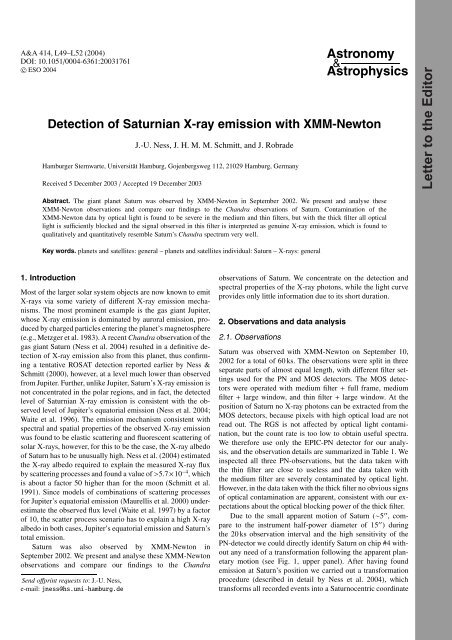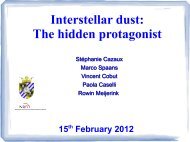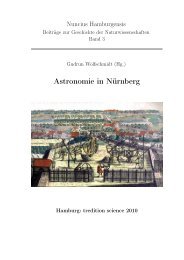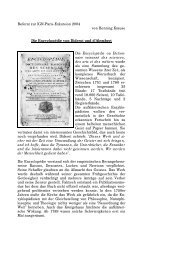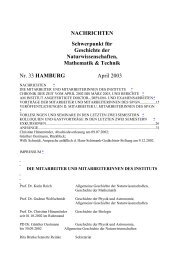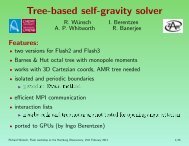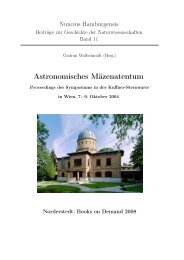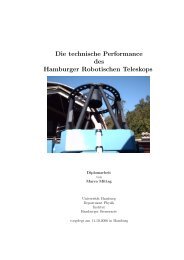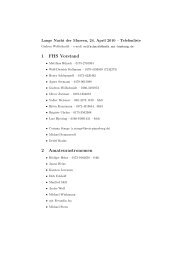pdf version - Hamburger Sternwarte - Universität Hamburg
pdf version - Hamburger Sternwarte - Universität Hamburg
pdf version - Hamburger Sternwarte - Universität Hamburg
Create successful ePaper yourself
Turn your PDF publications into a flip-book with our unique Google optimized e-Paper software.
A&A 414, L49–L52 (2004)<br />
DOI: 10.1051/0004-6361:20031761<br />
c○ ESO 2004<br />
Astronomy<br />
&<br />
Astrophysics<br />
Detection of Saturnian X-ray emission with XMM-Newton<br />
J.-U. Ness, J. H. M. M. Schmitt, and J. Robrade<br />
<strong><strong>Hamburg</strong>er</strong> <strong>Sternwarte</strong>, Universität <strong>Hamburg</strong>, Gojenbergsweg 112, 21029 <strong>Hamburg</strong>, Germany<br />
Received 5 December 2003 / Accepted 19 December 2003<br />
Letter to the Editor<br />
Abstract. The giant planet Saturn was observed by XMM-Newton in September 2002. We present and analyse these<br />
XMM-Newton observations and compare our findings to the Chandra observations of Saturn. Contamination of the<br />
XMM-Newton data by optical light is found to be severe in the medium and thin filters, but with the thick filter all optical<br />
light is sufficiently blocked and the signal observed in this filter is interpreted as genuine X-ray emission, which is found to<br />
qualitatively and quantitatively resemble Saturn’s Chandra spectrum very well.<br />
Key words. planets and satellites: general – planets and satellites individual: Saturn – X-rays: general<br />
1. Introduction<br />
Most of the larger solar system objects are now known to emit<br />
X-rays via some variety of different X-ray emission mechanisms.<br />
The most prominent example is the gas giant Jupiter,<br />
whose X-ray emission is dominated by auroral emission, produced<br />
by charged particles entering the planet’s magnetosphere<br />
(e.g., Metzger et al. 1983). A recent Chandra observation of the<br />
gas giant Saturn (Ness et al. 2004) resulted in a definitive detection<br />
of X-ray emission also from this planet, thus confirming<br />
a tentative ROSAT detection reported earlier by Ness &<br />
Schmitt (2000), however, at a level much lower than observed<br />
from Jupiter. Further, unlike Jupiter, Saturn’s X-ray emission is<br />
not concentrated in the polar regions, and in fact, the detected<br />
level of Saturnian X-ray emission is consistent with the observed<br />
level of Jupiter’s equatorial emission (Ness et al. 2004;<br />
Waite et al. 1996). The emission mechanism consistent with<br />
spectral and spatial properties of the observed X-ray emission<br />
was found to be elastic scattering and fluorescent scattering of<br />
solar X-rays, however, for this to be the case, the X-ray albedo<br />
of Saturn has to be unusually high. Ness et al. (2004) estimated<br />
the X-ray albedo required to explain the measured X-ray flux<br />
by scattering processes and found a value of >5.7×10 −4 ,which<br />
is about a factor 50 higher than for the moon (Schmitt et al.<br />
1991). Since models of combinations of scattering processes<br />
for Jupiter’s equatorial emission (Maurellis et al. 2000) underestimate<br />
the observed flux level (Waite et al. 1997) by a factor<br />
of 10, the scatter process scenario has to explain a high X-ray<br />
albedo in both cases, Jupiter’s equatorial emission and Saturn’s<br />
total emission.<br />
Saturn was also observed by XMM-Newton in<br />
September 2002. We present and analyse these XMM-Newton<br />
observations and compare our findings to the Chandra<br />
Send offprint requests to: J.-U. Ness,<br />
e-mail: jness@hs.uni-hamburg.de<br />
observations of Saturn. We concentrate on the detection and<br />
spectral properties of the X-ray photons, while the light curve<br />
provides only little information due to its short duration.<br />
2. Observations and data analysis<br />
2.1. Observations<br />
Saturn was observed with XMM-Newton on September 10,<br />
2002 for a total of 60 ks. The observations were split in three<br />
separate parts of almost equal length, with different filter settings<br />
used for the PN and MOS detectors. The MOS detectors<br />
were operated with medium filter + full frame, medium<br />
filter + large window, and thin filter + large window. At the<br />
position of Saturn no X-ray photons can be extracted from the<br />
MOS detectors, because pixels with high optical load are not<br />
read out. The RGS is not affected by optical light contamination,<br />
but the count rate is too low to obtain useful spectra.<br />
We therefore use only the EPIC-PN detector for our analysis,<br />
and the observation details are summarized in Table 1. We<br />
inspected all three PN-observations, but the data taken with<br />
the thin filter are close to useless and the data taken with<br />
the medium filter are severely contaminated by optical light.<br />
However, in the data taken with the thick filter no obvious signs<br />
of optical contamination are apparent, consistent with our expectations<br />
about the optical blocking power of the thick filter.<br />
Due to the small apparent motion of Saturn (∼5 ′′ ,compare<br />
to the instrument half-power diameter of 15 ′′ ) during<br />
the 20 ks observation interval and the high sensitivity of the<br />
PN-detector we could directly identify Saturn on chip #4 without<br />
any need of a transformation following the apparent planetary<br />
motion (see Fig. 1, upper panel). After having found<br />
emission at Saturn’s position we carried out a transformation<br />
procedure (described in detail by Ness et al. 2004), which<br />
transforms all recorded events into a Saturnocentric coordinate
L50<br />
J.-U. Ness et al.: XMM observation of Saturn<br />
Letter to the Editor<br />
Table 1. Overvation details for Saturn (only EPIC/PN).<br />
ObsID 0089370501<br />
Exp. time<br />
24 024 ks<br />
Start Time 2002-10-01 10:35<br />
Stop Time 2002-10-01 17:15<br />
PN filter<br />
THICK FILTER<br />
on-time (PN)<br />
21 047 ks<br />
ObsID 0089370601<br />
Exp. time<br />
24 023 ks<br />
Start Time 2002-10-01 17:35<br />
Stop Time 2002-10-02 00:15<br />
PN filter<br />
MEDIUM FILTER<br />
on-time (PN)<br />
20 966 ks<br />
ObsID 0089370701<br />
Exp. time<br />
24 023 ks<br />
Start Time 2002-10-02 00:37<br />
Stop Time 2002-10-02 07:17<br />
PN filter<br />
THIN FILTER1<br />
on-time (PN)<br />
20 962 ks<br />
Angular diam. 18.1 ′′<br />
distance (Earth)<br />
9.2 AU<br />
distance (Sun)<br />
9.0 AU<br />
inclination<br />
−26.4 ◦<br />
system, and constructed an image in this new coordinate system.<br />
We then extracted all photons within an extraction radius<br />
of 25 ′′ around the central position of the transformed coordinate<br />
system, where an enhancement of photons can be immediately<br />
recognized (cf. Fig. 1). In a circular detect cell we extract<br />
162 photons while from the background (extracted from<br />
an adjacent 80 ′′ ×200 ′′ box) we expect only 50.2 photons. With<br />
a total of 112 ± 13 counts we have therefore obtained a highly<br />
significant detection.<br />
3. Results<br />
We analyzed the XMM-Newton EPIC-PN data of Saturn in<br />
the same fashion as the Chandra data as described by Ness<br />
et al. (2004). Since the recorded count number is exactly the<br />
same (!), the detection significance in both data sets is very similar;<br />
note, that the background values differ somewhat. Since<br />
the angular resolution of the XMM-Newton data is lower, we<br />
are not able to locate the X-ray emission on Saturn’s apparent<br />
disk (diameter 18.1 ′′ ) from our XMM-Newton observations.<br />
We extracted the light curve with different time bins but<br />
found no significant variability. The net count rate is (5.3 ±<br />
0.6) × 10 −3 cps. Only half a rotation is covered with the short<br />
observation time and no phase variability can be tested.<br />
Is the signal recorded in the thick filter due to X-rays or<br />
also due to optical contamination? In order to address this<br />
issue we analyzed the EPIC-PN medium filter data in precisely<br />
the same fashion as the thick filter data and extracted<br />
a background-subtracted spectrum of the photons attributed to<br />
Fig. 1. Photon positions on PN chip #4 (upper panel; with expected<br />
path of Saturn) and transformed positions in “saturnocentric” coordinates<br />
(bottom). 162 counts are extracted in a circle with radius 25 ′′<br />
and 409 counts in an 80 ′′ ×200 ′′ background box.<br />
Saturn (cf. Fig. 2). The strong signal increase towards lower<br />
energies is the indicator of the severe contamination due to optical<br />
light. In contrast, carrying out the same procedure with<br />
the thick filter data results in a spectrum looking totally different<br />
(cf. Fig. 3). The thick filter spectrum does not exhibit<br />
any increase towards lower energies as expected from a genuine<br />
X-ray spectrum, since the effective areas decrease towards<br />
lower energies. Further, the thick filter spectrum appears very<br />
similar to the recorded Chandra spectrum, which is overplotted<br />
in a light color after scaling to our exposure time and extraction<br />
area. The signal is lower due to the lower effective areas<br />
of Chandra mirrors, with the Chandra spectrum appearing<br />
somewhat shifted towards higher energies. This might be due<br />
to some optical loading in the Chandra observation, an effect<br />
that could not fully be excluded by Ness et al. (2004). A rather<br />
weak emission feature appears at ∼1.3 keV, but is not significant;<br />
interestingly it is also seen in the Chandra spectrum.<br />
Using XSPEC we carried out spectral modeling similar<br />
to Ness et al. (2004), who found acceptable spectral fits<br />
with a (physically unmotivated) black body model and a<br />
combined MEKAL model plus a fluorescent line of oxygen.
J.-U. Ness et al.: XMM observation of Saturn<br />
L51<br />
Letter to the Editor<br />
Fig. 2. Spectrum extracted from the PN observation using the medium<br />
filter (ObsID 0089370601). Clear indications of optical contamination<br />
can be identified.<br />
Table 2. Saturn – spectral fits and fluxes.<br />
Model kT (keV) a χ 2 red / d.o.f.b flux e<br />
EPIC/PN<br />
(erg/cm 2 /s)<br />
black body 0.16 ± 0.03 1.09/9 1.66 × 10 −14<br />
APEC c 0.29 ± 0.05 0.79/9 1.62 × 10 −14<br />
APEC c +<br />
narrow line d 0.33 ± 0.08 0.41/8 1.58 f × 10 −14<br />
Chandra<br />
black body 0.18 0.7/10 0.44 × 10 −14<br />
MEKAL+ 0.39 ± 0.08 ↓ 0.55 × 10 −14<br />
narrow line – 0.9/9 0.13 × 10 −14<br />
ROSAT – – 1.9 × 10 −14<br />
a 90% errors. b Degrees of freedom. c Solar abundances. d At 527 eV,<br />
delta profile. e 0.1–2 keV. f 1.36 × 10 −14 (APEC) + 0.22×10 −14 (fluorescent<br />
line).<br />
Fig. 3. Extracted spectra for the background and source+background<br />
(top). The Chandra spectrum, scaled to our exposure time and source<br />
extraction area, is overplotted. Bottom: rebinned spectrum containing<br />
at least 15 counts per bin with two models obtained with XSPEC. The<br />
best-fit model consists of an APEC model and an oxygen fluorescent<br />
line (see Table 2).<br />
MEKAL contains continuum and line emissivities from collisionally<br />
ionized plasma in thermal equilibrium. This model<br />
is supposed to represent the spectrum of the solar corona<br />
and the model parameters are the equilibrium temperature<br />
and elemental abundances. Given the low signal-to-noise of<br />
our XMM-Newton data, we can only check to what extent<br />
the XMM-Newton and Chandra spectra are consistent with<br />
each other. We rebinned the XMM-Newton spectrum to contain<br />
at least 15 counts per bin, necessary to remain outside<br />
the Poissonian regime, otherwise a non-standard statistical<br />
treatment is necessary (e.g., Cash 1979; Ness & Wichmann<br />
2002). In addition we applied the Cash statistics provided by<br />
XSPEC with the original spectrum and found consistent results.<br />
In order to present a concise goodness-of-fit parameter<br />
we here present our results from χ 2 fits. Our best-fit black<br />
body model yields a temperature of kT = 0.16 ± 0.03 keV<br />
(χ 2 red<br />
= 1.09 with 9 d.o.f.), consistent with the temperature<br />
found from the Chandra observation (0.18 keV). Instead of a<br />
MEKAL model we chose an APEC model to describe an incident<br />
solar spectrum. Assuming solar abundances we find a<br />
temperature of kT = 0.29 ± 0.05 keV (χ 2 red<br />
= 0.79<br />
with 9 d.o.f.), a little cooler than the temperature found from the<br />
combined MEKAL/fluorescent line model from the Chandra<br />
spectrum (kT = 0.39 ± 0.08 keV). A slightly better fit is obtained<br />
by introducing an oxygen fluorescent line at 527 eV<br />
(modeled as a narrow emission line, only instrumentally broadened).<br />
With this combined model we obtain an APEC temperature<br />
of kT = 0.33 ± 0.08 keV, consistent with the Chandra results<br />
(χ 2 red<br />
= 0.41 with 8 d.o.f.). The fit results are summarized<br />
in Table 2 and in the last column we list the model fluxes, integrated<br />
in the wavelength interval 0.1–2 keV. For an overview of<br />
the available X-ray spectra of Saturn we plot the rebinned spectrum<br />
with the APEC model (dashed) and the best-fit model of<br />
the combined APEC/fluorescent line (solid grey) in the bottom<br />
panel of Fig. 3.<br />
While none of the considered spectral models may be<br />
physically correct, they allow a reasonable accurate estimate<br />
of the X-ray flux recorded by XMM-Newton. An<br />
inspection of Table 2 shows, that an apparent X-ray flux<br />
between 1.58−1.66 × 10 −14 erg cm −2 s −1 was recorded by
L52<br />
J.-U. Ness et al.: XMM observation of Saturn<br />
Letter to the Editor<br />
XMM-Newton. This compares well with the ROSAT flux<br />
of 1.9 × 10 −14 erg cm −2 s −1 (in the soft ROSAT band 0.1–<br />
0.55 keV) reported by Ness & Schmitt (2000), but is above the<br />
level measured by Chandra of 0.68 × 10 −14 erg cm −2 s −1 . Thus<br />
an interpretation of the signal recorded by XMM-Newton in the<br />
thick filter as genuine X-ray emission yields flux values consistent<br />
with earlier observations of X-ray emission from Saturn<br />
as well as an X-ray spectrum consistent with that recorded by<br />
Chandra. We therefore conclude that indeed true X-ray emission<br />
from Saturn has been recorded by XMM-Newton.<br />
4. Discussion and conclusions<br />
We analyzed XMM-Newton observations of Saturn. Because<br />
of Saturn’s visual magnitude of m V = 0.9 at the time of our<br />
observations, the data taken with the thin and the medium<br />
filters are severely contaminated by optical light. However, the<br />
data taken with the thick filter are exclusively X-ray photons<br />
originating from Saturn. Thus, X-ray emission from Saturn has<br />
been established to be significantly weaker than for Jupiter; the<br />
reported flux levels range from 0.68 × 10 −14 erg cm −2 s −1 from<br />
Chandra to 1.9 × 10 −14 erg cm −2 s −1 in a marginal ROSAT detection<br />
(Ness & Schmitt 2000). At least between the Chandra<br />
and XMM-Newton observations substantial variablity seems to<br />
have taken place, a fact hardly surprising for almost any X-ray<br />
source. The spectral models found to be consistent with the<br />
XMM-Newton data are also consistent (to within the errors)<br />
with the results from the Chandra observation. Any possibly<br />
remaining problems with optical loading do not seem to significantly<br />
affect the results. Further insights into Saturn’s X-ray<br />
production process require substantially deeper pointings than<br />
presently available.<br />
Acknowledgements. This work is based on observations obtained<br />
with XMM-Newton, an ESA science mission with instruments and<br />
contributions directly funded by ESA Member States and the USA<br />
(NASA). We also thank Pedro Rodriguez from the XMM helpdesk<br />
for his assistance. J.-U.N. and J.R. acknowledge support from DLR<br />
under 50OR0105.<br />
References<br />
Cash, W. 1979, ApJ, 228, 939<br />
Maurellis, A. N., Cravens, T. E., Gladstone, G. R., Waite, J. H., &<br />
Acton, L. W. 2000, Geophys. Res. Lett., 27, 1339<br />
Metzger, A. E., Gilman, D. A., Luthey, J. L., et al. 1983,<br />
J. Geophys. Res., 88, 7731<br />
Ness, J.-U., & Schmitt, J. H. M. M. 2000, A&A, 355, 394<br />
Ness, J.-U., Schmitt, J. H. M. M., Wolk, S., Dennerl, K., & Burwitz,<br />
V. 2004, A&A, accepted<br />
Ness, J.-U., & Wichmann, R. 2002, Astron. Nachr., 323, 129<br />
Schmitt, J. H. M. M., Snowden, S. L., Aschenbach, B., et al. 1991,<br />
Nature, 349, 583<br />
Waite, J. H., Gladstone, G. R., Lewis, W. S., et al. 1997, Science, 276,<br />
104<br />
Waite, J. H., Lewis, W. S., Gladstone, G. R., Fabian, A. C., & Brandt,<br />
W. N. 1996, in Roentgenstrahlung from the Universe, 641


